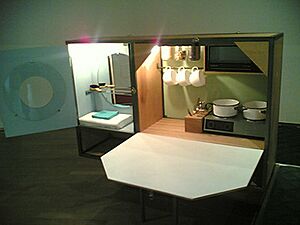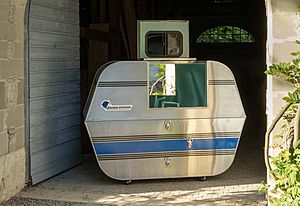Andrea Zittel facts for kids
Quick facts for kids
Andrea Zittel
|
|
|---|---|
| Born | 1965 (age 60–61) |
| Nationality | American |
| Education | Rhode Island School of Design, San Diego State University |
| Known for | Installation art, Social Practice, Contemporary Artist |
Andrea Zittel (born 1965) is an American artist. She lives and works in Joshua Tree, California. Her art explores big questions like "How should we live?" and "What makes life meaningful?"
Zittel's work mixes art, building design, and everyday objects. She creates "social sculptures" that turn daily tasks, like eating or sleeping, into cool experiments. These experiments show new ways of living.
Contents
Early Life and Education
Andrea Zittel was born in Escondido, California, in 1965. She finished high school in 1983. Zittel studied art at San Diego State University, getting her degree in painting and sculpture in 1988. She then earned a master's degree in sculpture from the Rhode Island School of Design in 1990.
Artistic Career
Exploring Daily Life Through Art
In the early 1990s, Andrea Zittel started making art from her own life. She created useful objects like furniture and clothing. Her goal was to understand human nature and what people truly need. She called her work "A-Z Administrative Services," which grew into the "A-Z Enterprise." This project looks at all parts of daily life.
Zittel believes that what seems normal or fixed is often just a choice. She wants people to think about their own goals and talents. Then, they can invent new ways of living that fit their needs.
In 2005, Zittel wrote:
"What makes us feel liberated is not total freedom, but rather living in a set of limitations that we have created and prescribed for ourselves."
In the early 1990s, Zittel's studio in Brooklyn became a testing ground called "A-Z East." Here, she tried out her experimental designs for living. For example, in 1991, she made her first "A-Z Six-Month Personal Uniforms." These were clothes she wore every day for six months. Many of her projects set strict rules for living. However, Zittel suggests these rules can actually lead to more freedom and creativity.
In 1992, Zittel created the "A-Z Management and Maintenance Unit." This was her first "Living Unit." These structures were designed to fit everything needed for living into a small, simple system. Her first unit helped her live in her tiny 200-square-foot apartment in Brooklyn. It had a small dining area, a sink, a stovetop, a closet, a bed, and a stool.
Even though they look like mass-produced items, Zittel's "Living Units" are very personal. They are made for each person's specific needs. Her art encourages people to think about their own needs and daily routines. Zittel said that while mass production makes things equal, it can also reduce individuality. She believes people should redefine objects based on their own needs.
Some of Zittel's designs aimed to make daily life simpler. Others, like her "Escape Vehicles" from 1996, explored the idea of getting away from the world. In 1998, Zittel developed her "Rules of Raugh" (pronounced raw). This led to new living spaces and furniture. Unlike her earlier focus on efficiency, the "Raugh" works looked unfinished and were easy to maintain.
A-Z West: Desert Living Experiment
In 2000, Zittel moved her home and studio from Brooklyn, NY to the California desert. She bought five acres near Joshua Tree National Park. Here, she created "A-Z West," a large-scale project to test her ideas about living. The environment itself helps shape the experience.
A-Z West now covers over 50 acres and includes many projects. These include Zittel's home, the Wagon Station Encampment, and a weaving studio. One of her first projects there was the "Homestead Unit" (2001). These are small, portable structures. They are so small they don't need building permits, like the homes from the old Homestead Acts.
Scattered around A-Z West are twelve "Wagon Stations." These are small, portable shelters for one person. Artists and thinkers can stay in them each spring and fall. Zittel was inspired by land artists like Walter de Maria.
Zittel also explores the idea of "panels" or "planes." These are the basic flat surfaces that make up our world. Through works like "Personal Panel Uniforms" and "Carpet Furniture," she questions what horizontal and vertical surfaces mean to us.
Public Art Projects
In 1999, Andrea Zittel created her first public art project for Central Park in New York. Called "Point of Interest," it featured two giant fake rocks made of steel and concrete. These rocks reminded visitors that the park is a carefully designed natural space. They also offered a different place to sit than a typical park bench.
That same year, Zittel made "A-Z Pocket Property." This was a 44-ton floating concrete island off the coast of Denmark. The Danish government asked her to create it. Zittel lived on this "fantasy island" for one month. It was an experiment about escaping and being alone.
In 2010, she created "Indianapolis Island." This was another floating island at the Indianapolis Museum of Art. Zittel said, "The Island represents ideas of being independent and individual in our culture."
In 2014, the Denver Federal Center in Colorado asked her to create a large outdoor art piece called "Planar Pavilions."
Working with Others
Andrea Zittel helped start High Desert Test Sites. This is a non-profit group that supports experimental art in the California desert. These sites allow artists and thinkers to share ideas and experiences. They offer trips, art projects, workshops, and residencies.
From 2006 to 2010, Zittel also helped run the A-Z smockshop in Los Angeles. This was a business run by artists to help other artists earn money. Andrea Zittel designed smocks, and artists sewed them, adding their own creative touches.
Teaching and Mentoring
Andrea Zittel teaches an intense eight-day art seminar once a year at A-Z West. This program, called The Institute for Investigative Living, focuses on "Life Practice." It explores how artists can live a meaningful life, no matter what the art market or other outside factors say. Zittel also visits Columbia University regularly to give advice to students in their Master of Fine Arts program.
Exhibitions and Recognition
Andrea Zittel's art has been shown in many important places around the world. She was part of the Venice Biennale in 1993 and Documenta X in 1997. Her work was also featured in the Whitney Biennial in 1995 and 2004.
She has had solo shows at major museums like the San Francisco Museum of Modern Art (1995) and the Whitney Museum of American Art in New York (2006). A big show of her work from 1991 to 2005, called "Andrea Zittel: Critical Space," traveled to several museums, including the New Museum of Contemporary Art in New York (2006) and the Los Angeles Museum of Contemporary Art (2007).
Awards and Honors
Andrea Zittel has received many awards for her art. In 1995, she received a DAAD fellowship. In 2005, she won the Smithsonian American Art Museum's Lucelia Artist Award. The College Art Association gave her the Distinguished Body of Work Award in 2006. In 2007, she received the AICA Award for Best Architecture or Design Show. In 2012, she was awarded the Austrian Frederick Kiesler Prize for Architecture and the Arts. Most recently, in 2015, Zittel received a Guggenheim Fellowship for Fine Arts.
Art in Collections
Zittel's art is part of the permanent collections of many famous museums. These include the Solomon R. Guggenheim Museum, the Whitney Museum of American Art, and the Metropolitan Museum of Art. The Museum of Modern Art in New York has 33 of her works in its collection.
See also
- List of artists from Brooklyn
- A-Z West



